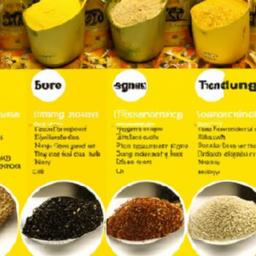Couscous vs. Quinoa: A Detailed Comparison for Your Next Meal
Though couscous and quinoa are both small, grain-like foods found in kitchens worldwide, their origins, flavors, and nutritional profiles could not be more different. At How To Cook Gourmet, we love diving into the nuances behind everyday ingredients. If you’re debating which of these to choose for a quick dinner or a nutrient-dense meal, this guide will help you make an informed decision.
Getting to Know Couscous and Quinoa: Origins and Characteristics
Many assume couscous and quinoa are similar types of grains, but their backgrounds and botanical classifications set them apart.
Couscous is not truly a grain-it’s a tiny pellet-shaped pasta derived from semolina wheat. Thanks to its pasta nature, couscous cooks rapidly and offers a soft, delicate texture that blends seamlessly with many dishes. Despite its refined wheat base, it generally contains less protein compared to quinoa.
Quinoa, conversely, is a seed originally cultivated in the Andean regions of South America. Its distinct nutty flavor and lightly crunchy bite have earned it superfood status in recent years. Quinoa is celebrated for its high protein content, including all nine essential amino acids, making it an excellent choice for those boosting plant-based protein intake.
| Aspect | Couscous | Quinoa |
|---|---|---|
| Type | Wheat-based pasta | Seed with grain-like qualities |
| Typical Cooking Time | Approximately 5 minutes | About 15 minutes (after rinsing) |
| Protein (per 100g) | 3 grams | 8 grams |
| Gluten Content | Contains gluten | Gluten-free |
| Texture | Soft, fluffy | Lightly crunchy and chewy |
Whether you need a quick fix or a nutrient-rich foundation, couscous and quinoa both hold distinct culinary advantages tailored to varied tastes and lifestyles.
Nutritional Face-off: Which Offers More Benefits?
When selecting foods for vitality and satiety, nutritional content often reigns supreme. Comparing a cooked cup of couscous with the same amount of quinoa reveals clear differences in nutrient density:
| Nutrient | Couscous (1 cup, cooked) | Quinoa (1 cup, cooked) |
|---|---|---|
| Calories | 176 | 222 |
| Protein (grams) | 6 | 8 |
| Dietary Fiber (grams) | 2 | 5 |
| Iron (mg) | 0.6 | 2.8 |
| Magnesium (mg) | 24 | 118 |
Quinoa’s richer protein and fiber content provide longer-lasting fullness and support muscle maintenance. Its superior iron and magnesium levels contribute to enhanced energy metabolism and blood health. Conversely, couscous’s lower calorie count and quicker preparation time offer advantages when time is tight.
Ultimately, the choice narrows down to your priorities: speed and convenience or a nutrient-packed ingredient that fuels your body more comprehensively.
Speed and Technique: How to Cook Couscous and Quinoa Efficiently
For busy cooks, the length of time grains take to prepare can be a deciding factor. Couscous is famed for its lightning-fast cooking-ready in just about five minutes, it’s perfect for those evenings when hunger leaves no room for delays.
Quinoa demands a bit more patience, with a typical cooking time near 15 minutes. However, this extra wait is justified by its superior nutritional profile. Rinsing quinoa before cooking is essential to remove the natural saponins that lend a bitter taste if left untreated.
| Grain | Cooking Duration | Preparation Tip |
|---|---|---|
| Couscous | 5 minutes | Pour in boiling water, cover tightly, then fluff with a fork |
| Quinoa | 15 minutes | Rinse thoroughly before simmering to avoid bitterness |
- Boiling water speeds couscous cooking.
- Cover during cooking to trap steam for fluffiness.
- Gentle fluffing preserves the light texture of couscous.
Choosing between these grains may come down to whether you prioritize swift preparation or a richer nutrient profile in your mealtime ritual.
Flavor Profiles: How Taste Influences Culinary Uses
Flavor differences between couscous and quinoa greatly influence how they complement dishes.
Couscous boasts a subtle, almost neutral taste, dexterously absorbing the boldness of accompanying spices and sauces without overshadowing them. It acts as a blank canvas in many savory recipes.
Quinoa delivers a slightly nutty and earthy flavor with traces of bitterness, which can enhance salads, grain bowls, and dishes where its personality shines distinctly.
| Flavor Characteristic | Couscous | Quinoa |
|---|---|---|
| Primary Taste | Mild, understated | Nutty with a subtle bitter note |
| Texture | Soft and airy | Chewy with slight crunch |
| Ideal Pairings | Rich stews, saucy dishes, herbs and spices | Fresh salads, grain bowls, roasted vegetables |
To accentuate quinoa’s natural flavor, a splash of citrus like lemon juice or a sprinkle of fresh herbs works wonders. Conversely, couscous pairs beautifully with warm spices such as cinnamon or a drizzle of quality olive oil. These flavor pairings tailor each grain perfectly to various culinary contexts.
The Importance of Texture: Engaging Your Palate
Texture is a subtle yet crucial component that shapes how we enjoy food. Couscous offers a delicate, pillowy softness that melts effortlessly in the mouth. Quinoa presents a lively chewiness with a slight pop in every bite, adding dimension to the eating experience.
| Grain | Texture | Mouthfeel |
|---|---|---|
| Couscous | Light and fluffy | Gently dissolves in the mouth |
| Quinoa | Firm and crunchy | Chewy, with a vibrant bite |
When crafting recipes, balancing textures-for instance, combining something soft with a crunchy element-can awaken taste buds and add excitement throughout the meal. Monotonous textures can lead to culinary boredom, while varied mouthfeel enhances satisfaction.
- Contrast: Pairing soft and crunchy textures enlivens your dish.
- Balance: Maintaining a dynamic mouthfeel prevents meals from feeling flat.
- Experience: Diverse textures strengthen memorable eating experiences.
Allergies and Sensitivities: What to Know Before You Eat
Dietary restrictions are an important consideration when choosing between couscous and quinoa.
Couscous contains gluten because it is derived from wheat, making it unsuitable for those with celiac disease or gluten intolerance. In contrast, quinoa is inherently gluten-free, appealing to those on gluten-restricted diets.
However, quinoa contains saponins-a natural coating that can cause digestive irritation for sensitive individuals if not properly rinsed before cooking. Couscous does not have this compound, potentially offering a gentler option for some.
| Dietary Factor | Couscous | Quinoa |
|---|---|---|
| Gluten Presence | Yes | No |
| Saponins | No | Yes (requires thorough rinsing) |
| Allergy Concerns | Wheat allergy possible | Rare quinoa allergies reported |
Additionally, quinoa’s higher fiber content may be beneficial for digestive health but could be challenging for some with sensitive gastrointestinal systems. When selecting grains, consider both your nutritional needs and digestive comfort.
Versatility in Cooking: Creative Ways to Use Couscous and Quinoa
Both couscous and quinoa lend themselves well to a variety of dishes, from quick salads to hearty main courses, elevating everyday meals with minimal fuss.
Couscous excels at soaking up savory sauces and spices, making it a favorite base for North African and Mediterranean dishes. Its fluffy texture complements rich stews and vegetable medleys perfectly.
Quinoa brings a dynamic nutty flavor and chewy texture that pairs wonderfully with fresh vegetables, nuts, and proteins, making it a staple in wholesome salads, nutritious bowls, and warm side dishes.
| Characteristic | Couscous | Quinoa |
|---|---|---|
| Cooking Time | 5 minutes using boiling water | 15 minutes simmering, after rinsing |
| Texture | Soft and fluffy | Chewy with slight crunch |
| Common Uses | Salads, side dishes, tagines | Salads, protein bowls, warm sides |
Try these ideas to showcase either grain:
- Combine with oven-roasted vegetables and a zesty vinaigrette for a quick, vibrant salad.
- Enhance with fresh herbs like parsley, cilantro, or basil plus a hint of citrus zest.
- Top with grilled chicken, chickpeas, or tofu for a protein-packed finishing touch.
Experimenting with both grains in your kitchen can invigorate your meal planning and open doors to exciting flavors and textures.
Frequently Asked Questions
Q: What exactly are couscous and quinoa?
Couscous is a small pasta made from semolina wheat, popular in North African cooking. Quinoa is a nutrient-dense seed from South America that behaves like a grain when cooked. Despite appearances, their botanical origins differ.
Q: How do cooking methods vary?
Couscous requires pouring boiling water over it and covering for 5 minutes. Quinoa takes approximately 15 minutes to simmer after being rinsed thoroughly to remove its natural coatings.
Q: Which is a healthier option?
Quinoa generally offers more protein, fiber, and essential minerals. Couscous has fewer nutrients but still makes a satisfying side. Your choice depends on dietary goals and restrictions.
Q: How do their flavors and textures compare?
Couscous provides a mild, soft texture that absorbs other flavors well. Quinoa offers a nutty flavor with an enjoyable crunch. Preferences vary depending on desired mouthfeel.
Q: Where do each best fit in meals?
Couscous frequently complements stews and saucy dishes, while quinoa is versatile enough for salads, bowls, or as a side ingredient.
Q: What about allergies and gluten concerns?
Those avoiding gluten should opt for quinoa. People with wheat allergies should avoid couscous. Quinoa requires rinsing to reduce natural bitter compounds which may cause minor sensitivities.
Q: Are they similarly priced?
Couscous is typically more budget-friendly and widely available. Quinoa often costs more but has become mainstream in many supermarkets.
Quick Overview Table:
| Feature | Couscous | Quinoa |
|---|---|---|
| Origin | Semolina wheat pasta | Seed from Andes region |
| Cooking Time | 5 minutes | 15 minutes |
| Gluten-Free | No | Yes |
| Protein Content | Low | High |
| Taste | Neutral, mild | Nutty, crunchy |
| Price | Economical | Moderate to high |
The Takeaway: Choosing What Suits You Best
Both couscous and quinoa have unique strengths that can enhance your culinary repertoire. Couscous offers rapid preparation and a gentle flavor, ideal for quick meals and dishes where other ingredients lead. Quinoa delivers more comprehensive nutrition and an assertive taste and texture, suitable for health-conscious eaters and flavor enthusiasts.
Consider your taste preferences, nutritional goals, dietary restrictions, and time constraints when selecting between these two. Incorporating both into your cooking can diversify meals and keep your palate curious. Ready to experiment in the kitchen with these versatile staples? Dive in-you might discover a new favorite.




